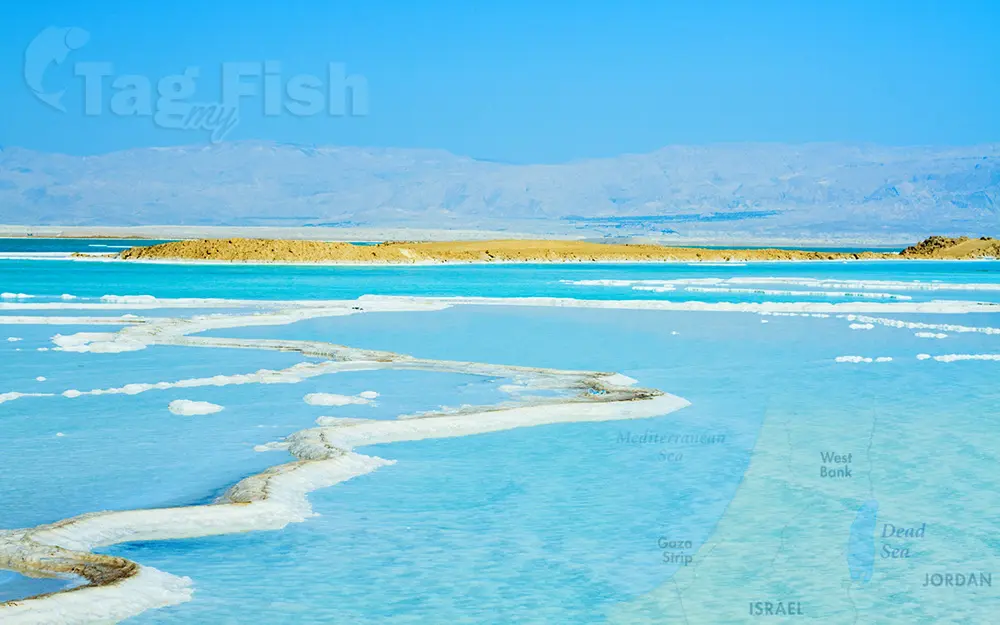Dead sea

General data
- Name: Dead sea
- Water system: Planet Earth
- Water type: Endorheic lake
- Progression: Planet Earth
- Climates: Tropical, Arid (desert)
- Continents: Asia
- Countries: Israel, Jordan
The Dead Sea, also known by other names, is a salt lake bordered by Jordan to the east and Israel and the West Bank to the west. It lies in the Jordan Rift Valley, and its main tributary is the Jordan River. The lakes surface is 430.5 metres (1,412 ft) below sea level, making its shores the lowest land-based elevation on Earth. It is 304 m (997 ft) deep, the deepest hypersaline lake in the world. With a salinity of 342 g/kg, or 34.2% (in 2011), it is one of the worlds saltiest bodies of water – 9.6 times as salty as the ocean – and has a density of 1.24 kg/litre, which makes swimming similar to floating. This salinity makes for a harsh environment in which plants and animals cannot flourish, hence its name. The Dead Seas main, northern basin is 50 kilometres (31 mi) long and 15 kilometres (9 mi) wide at its widest point. The Dead Sea has attracted visitors from around the Mediterranean Basin for thousands of years. It was one of the worlds first health resorts (for Herod the Great), and it has been the supplier of a wide variety of products, from asphalt for Egyptian mummification to potash for fertilisers. Today, tourists visit the sea on its Israeli, Jordanian and West Bank coastlines. The Palestinian tourism industry has been met with setbacks in developing along the West Bank coast. The Dead Sea is receding at a swift rate; its surface area today is 605 km2 (234 sq mi), having been 1,050 km2 (410 sq mi) in 1930. The recession of the Dead Sea has begun causing problems, and multiple canal and pipeline proposals have been made to reduce its recession. One of these proposals is the Red Sea–Dead Sea Water Conveyance pipeline project, which would provide water to neighbouring countries and carry brine to the Dead Sea to help stabilise its water level. The sea is called dead because its high salinity prevents macroscopic aquatic organisms, such as fish and aquatic plants, from living in it, though minuscule quantities of bacteria and microbial fungi are present. In times of flood, the salt content of the Dead Sea can drop from its usual 35% to 30% or lower. The Dead Sea temporarily comes to life in the wake of rainy winters. In 1980, after one such rainy winter, the normally dark blue Dead Sea turned red. Researchers from Hebrew University of Jerusalem found the Dead Sea to be teeming with an alga called Dunaliella. Dunaliella in turn nourished carotenoid-containing (red-pigmented) halobacteria, whose presence caused the color change. Since 1980, the Dead Sea basin has been dry and the algae and the bacteria have not returned in measurable numbers. Many animal species live in the mountains surrounding the Dead Sea. Hikers can see ibex, hares, hyraxes, jackals, foxes, and even leopards. Hundreds of bird species inhabit the zone as well. Both Jordan and Israel have established nature reserves around the Dead Sea. The delta of the Jordan River was formerly a jungle of papyrus and palm trees. The Jewish historian Flavius Josephus described Jericho as the most fertile spot in Judea.

 English
English
 Spanish
Spanish
 German
German
 French
French
 Serbian
Serbian
 Russian
Russian

